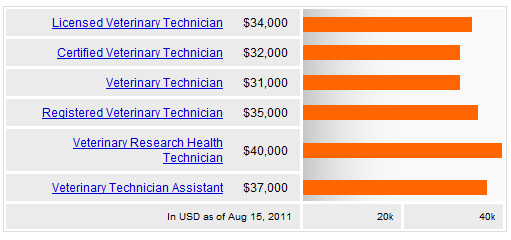Becoming a Veterinary Technician
Employment Outlook
The employment growth for veterinary technicians will increase by 36 percent over the next 10 years. An increase in biomedical research that supports human health will also contribute to the demand.
Salary

Currently, the average vet tech salary ranges between $31,500 and $35,000 depending on experience. The salary for top earners is approximately $41,500, while vet tech specialists can earn salaries in the $45,000+ range.
Duties & Responsibilities of a Vet Tech
Some of the duties performed by a veterinary technician include tissue and blood collection, urinalysis and medication administration. Those who work in a vet tech job may also fill prescriptions, perform first-aid techniques, and take x-rays and blood counts. Within some veterinary clinics, a veterinary technician is also responsible for keeping patient records, postoperative care and discussing the health and illness of a pet with its owners. For additional information, see job description.
If you are interested in the treatment and care of animals, the following steps will help you become a vet tech.
1. Obtain a Degree
You can complete a two-year training program at a vet tech school or a community college. Upon completion, you will receive an associate’s degree. Typical courses may include anatomy and physiology, nutrition, veterinary medical terminology, animal nursing, diagnostic imaging and pharmacology. Some programs also require completion of an internship.
2. Pass the VTNE Exam
After you finish your studies, you will need to take the Veterinary Technician National Exam (VTNE) administered by AAVSB.org.
3. Obtain State-Level Veterinary Credentials
After completing your degree, you will need to earn a certification to work as a vet tech. The credentialing requirements may vary among states. To work in a research setting, you may also get certification from a national association such as the AALAS (American Association for Laboratory Animal Science).
4. Get Job Experience in a Clinical or Research Setting
Most veterinary clinics and research facilities provide on-the-job training after you complete your degree and obtain credentials. An exception may apply if the veterinary training program you attended included extensive training for veterinary equipment. Explore our job listings in your area for openings.

